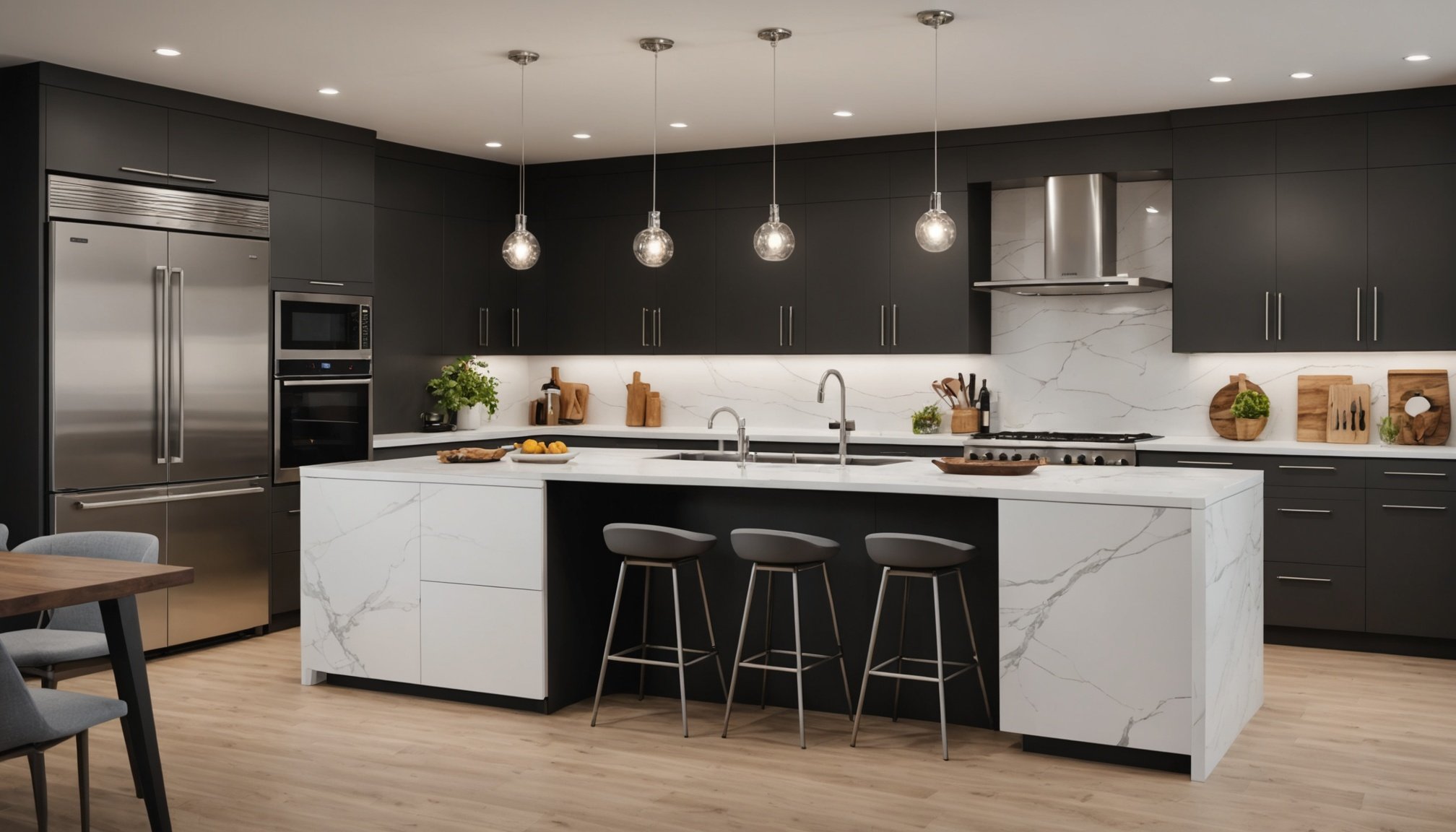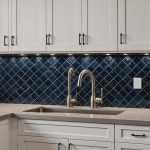Understanding Touchless Cabinet Technology
Touchless kitchen innovations are transforming how we interact with cabinetry, offering a sleek alternative to traditional cabinet designs. The primary aim of cabinet automation is to provide hands-free access to storage spaces, thus enhancing kitchen efficiency and hygiene. Unlike conventional cabinets that rely on manual effort to open and close, touchless cabinet technology employs sensors to detect movement or the presence of an object, allowing cabinet doors to operate effortlessly and intuitively.
These cabinets utilise advanced sensor technology, such as infrared or capacitive sensors, to identify when a tray or hand is near. This technology ensures that cabinets open automatically, often with a simple wave motion or proximity gesture, reducing the need to touch handles, which can be breeding grounds for germs.
Also read : Must-have mold-resistant backsplash materials for your kitchen: elevate aesthetics and hygiene
Materials used in touchless cabinets often include durable composites and metals, designed to withstand frequent use while maintaining a modern aesthetic. The comparison with traditional designs highlights the benefit of reduced physical contact, promoting cleaner kitchen environments. Overall, these hands-free access cabinets not only simplify daily chores but also offer a stylish, futuristic flair to contemporary kitchens.
Advantages of Touchless Cabinets in Modern Kitchens
Incorporating touchless cabinets into your kitchen design offers several benefits. One of the most notable perks is the enhanced convenience these cabinets provide for daily activities. Imagine being able to access utensils with a simple motion sensor or voice command, all hands-free. This ease of use is particularly beneficial when your hands are full or messy, streamlining your kitchen routine.
Have you seen this : Creative countertop edge designs that minimize spills and enhance style
Another significant advantage is the notable improvement in hygiene. By eliminating the need to physically touch cabinet handles, touchless technology helps reduce contact germs. This aspect is especially crucial in a space where food preparation occurs, helping maintain a cleaner and healthier environment.
Additionally, touchless cabinets come with accessibility features that are invaluable for elderly individuals or those with mobility challenges. These features allow differently-abled people to navigate the kitchen more independently, fostering a sense of confidence and self-reliance.
The adoption of touchless technology not only modernises your kitchen but also prioritises convenience, hygiene, and accessibility, making it a practical and forward-thinking choice for households. Whether you’re renovating an older space or building new, these cabinets are a valuable addition.
Installation Process of Touchless Cabinets
Embarking on the journey of installing touchless cabinets can be both exciting and rewarding. To start, gather all necessary tools and components. Typically, you’ll need a screwdriver, level, measuring tape, and the motorised mechanism for your cabinet setup. This equipment forms the backbone of your DIY touchless kitchen adventure.
Step-by-Step Guide for Installation
-
Preparation: Begin by removing any traditional cabinet hardware. Ensure you have accurate measurements for the new setup.
-
Mounting Mechanism: Attach the motorised mechanism following the manufacturer’s instructions. Precise placement is crucial for smooth operation.
-
Electrical Setup: Carefully connect the wiring. It’s essential to follow the electrical code guidelines to ensure safety.
-
Calibration: Test the system by opening and closing the cabinets, making adjustments for optimal performance.
Considerations for Professional Installation
While a DIY touchless kitchen offers a hands-on approach and potential cost savings, professional installation ensures precision. It’s particularly beneficial if you’re uncomfortable with electrical setups, as experts can handle complex installations seamlessly. Ultimately, the choice between DIY and professional installation depends on your comfort level and the complexity of your chosen cabinet setup. Make an informed decision to suit your needs.
Cost Considerations for Touchless Cabinets
When planning a kitchen remodel, understanding the financial commitment required for touchless cabinets is paramount. Costs can vary significantly, primarily depending on the materials and design complexity. Generally, touchless cabinet pricing starts around $500 per unit and can rise beyond $1,500. It’s crucial to align this with your overall budget for a modern kitchen to avoid overspending.
Besides the initial expense, consider the long-term savings. Touchless cabinets often incorporate energy-efficient systems, decreasing utility bills over time. Additionally, their sleek design and convenience markedly enhance your kitchen’s value, making them a worthwhile investment.
To stay within budget, explore different financing options, such as home improvement loans or extended payment plans offered by retailers. It’s also wise to set aside a contingency fund—around 10-15% of your budget—for unforeseen costs. Shopping during sales or negotiating with suppliers can also lead to significant savings.
Incorporating these cabinets in your kitchen design not only adds a modern touch but also boosts its functionality. Keep this in mind as you compare pricing options and track your spending meticulously. Balancing cost with quality ensures you get the best from your kitchen remodel.
Design Inspiration for Touchless Cabinets
In the realm of modern kitchen design, touchless cabinets are emerging as a game-changer. Their clean, seamless appearance aligns perfectly with contemporary aesthetics, providing both functionality and style.
Touchless Cabinetry Styles
Popular designs incorporating touchless cabinetry include minimalist kitchens with sleek lines and integrated handles. Scandinavian-inspired designs often favour light wood finishes, enhancing the airy feel of the space. Industrial styles pair well with touchless features too, combining metallic finishes and exposed brick for an urban vibe.
Color and Finish Options
When it comes to touches that blend into modern kitchen design, colour selection is crucial. Neutral tones like whites, greys, and earth hues are common, providing a timeless backdrop. High-gloss finishes can add a sophisticated touch, while matte options offer a softer, understated look. The choice of colour and finish should harmonize with existing decor to ensure aesthetic compatibility.
Examples of Innovative Layouts
Innovative kitchen layouts showcasing touchless cabinets often incorporate open shelving and fluid workspaces. This open-plan style suits both small kitchens seeking to maximize space and larger layouts desiring an expansive, cohesive flow. Such designs demonstrate how touchless cabinetry not only enhances functionality but also serves as a focal point in any contemporary kitchen.
User Reviews and Experiences with Touchless Cabinets
Exploring touchless cabinet reviews, many users have shared a plethora of insights on functionality. Homeowners often express enthusiasm over the convenience that touchless technology offers. User experiences frequently highlight the ease of accessing cabinets without the need for physical contact, particularly appreciated in kitchens and bathrooms where cleanliness is paramount. This touchless feature ranks high in providing a seamless, hygienic solution.
However, it’s not all smooth sailing. Some common issues include sensors being overly sensitive or, conversely, unresponsive at times. Users often report the need to adjust sensor calibration to ensure optimal functionality. Such insights into user experiences suggest that learning how to fine-tune these sensors can drastically improve daily usage.
The benefits certainly seem to outweigh the challenges, with many reviews celebrating the sleek design and modern appeal of touchless cabinets. For those encountering difficulties, the consensus suggests a review of the installation manual, often providing critical troubleshooting tips. Homeowners transitioning to this technology largely find it transformative, bringing a touch of innovation and convenience to everyday life.
Comparing Touchless Cabinets with Other Kitchen Technologies
In the realm of modern kitchen innovations, touchless cabinets offer a unique proposition compared to other kitchen technologies. While many smart kitchen devices focus on connectivity and automation, touchless cabinets prioritize functionality and usability.
The Rise of Smart Appliances
Smart appliances have become the forefront of kitchen technology comparison. From refrigerators that can suggest recipes based on their contents to ovens controllable via smartphone apps, these technologies aim to enhance culinary convenience. However, they often demand a certain level of tech-savviness from users, potentially creating a steep learning curve.
How Touchless Cabinets Stand Out
Touchless cabinets differentiate themselves through their straightforward integration into daily life. Unlike some smart devices that might require setup and constant updates, touchless cabinets enhance the tactile experience of the kitchen. Their sensor-based operation ensures that users can access stored items effortlessly, simplifying kitchen operations especially when hands are full or soiled.
Integrating Touchless Technology
When considering integration with existing systems, touchless cabinets exhibit a high compatibility factor. They can seamlessly fit into traditional setups without disrupting the aesthetic or functional flow of the kitchen. This adaptability, combined with the intuitive nature of their use, underscores their advantage in a modern kitchen technology comparison.











